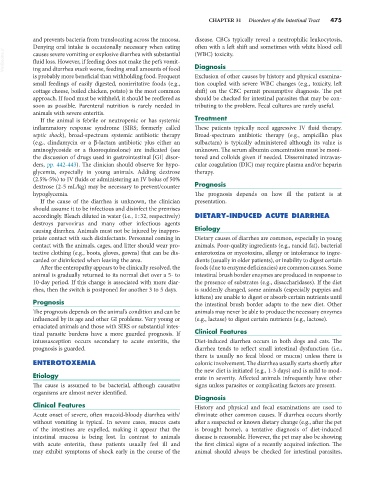Page 503 - Small Animal Internal Medicine, 6th Edition
P. 503
CHAPTER 31 Disorders of the Intestinal Tract 475
and prevents bacteria from translocating across the mucosa. disease. CBCs typically reveal a neutrophilic leukocytosis,
Denying oral intake is occasionally necessary when eating often with a left shift and sometimes with white blood cell
VetBooks.ir causes severe vomiting or explosive diarrhea with substantial (WBC) toxicity.
fluid loss. However, if feeding does not make the pet’s vomit-
Diagnosis
ing and diarrhea much worse, feeding small amounts of food
is probably more beneficial than withholding food. Frequent Exclusion of other causes by history and physical examina-
small feedings of easily digested, nonirritative foods (e.g., tion coupled with severe WBC changes (e.g., toxicity, left
cottage cheese, boiled chicken, potato) is the most common shift) on the CBC permit presumptive diagnosis. The pet
approach. If food must be withheld, it should be reoffered as should be checked for intestinal parasites that may be con-
soon as possible. Parenteral nutrition is rarely needed in tributing to the problem. Fecal cultures are rarely useful.
animals with severe enteritis.
If the animal is febrile or neutropenic or has systemic Treatment
inflammatory response syndrome (SIRS; formerly called These patients typically need aggressive IV fluid therapy.
septic shock), broad-spectrum systemic antibiotic therapy Broad-spectrum antibiotic therapy (e.g., ampicillin plus
(e.g., clindamycin or a β-lactam antibiotic plus either an sulbactam) is typically administered although its value is
aminoglycoside or a fluoroquinolone) are indicated (see unknown. The serum albumin concentration must be moni-
the discussion of drugs used in gastrointestinal [GI] disor- tored and colloids given if needed. Disseminated intravas-
ders, pp. 442-443). The clinician should observe for hypo- cular coagulation (DIC) may require plasma and/or heparin
glycemia, especially in young animals. Adding dextrose therapy.
(2.5%-5%) to IV fluids or administering an IV bolus of 50%
dextrose (2-5 mL/kg) may be necessary to prevent/counter Prognosis
hypoglycemia. The prognosis depends on how ill the patient is at
If the cause of the diarrhea is unknown, the clinician presentation.
should assume it to be infectious and disinfect the premises
accordingly. Bleach diluted in water (i.e., 1 : 32, respectively) DIETARY-INDUCED ACUTE DIARRHEA
destroys parvovirus and many other infectious agents
causing diarrhea. Animals must not be injured by inappro- Etiology
priate contact with such disinfectants. Personnel coming in Dietary causes of diarrhea are common, especially in young
contact with the animals, cages, and litter should wear pro- animals. Poor-quality ingredients (e.g., rancid fat), bacterial
tective clothing (e.g., boots, gloves, gowns) that can be dis- enterotoxins or mycotoxins, allergy or intolerance to ingre-
carded or disinfected when leaving the area. dients (usually in older patients), or inability to digest certain
After the enteropathy appears to be clinically resolved, the foods (due to enzyme deficiencies) are common causes. Some
animal is gradually returned to its normal diet over a 5- to intestinal brush border enzymes are produced in response to
10-day period. If this change is associated with more diar- the presence of substrates (e.g., disaccharidases). If the diet
rhea, then the switch is postponed for another 3 to 5 days. is suddenly changed, some animals (especially puppies and
kittens) are unable to digest or absorb certain nutrients until
Prognosis the intestinal brush border adapts to the new diet. Other
The prognosis depends on the animal’s condition and can be animals may never be able to produce the necessary enzymes
influenced by its age and other GI problems. Very young or (e.g., lactase) to digest certain nutrients (e.g., lactose).
emaciated animals and those with SIRS or substantial intes-
tinal parasite burdens have a more guarded prognosis. If Clinical Features
intussusception occurs secondary to acute enteritis, the Diet-induced diarrhea occurs in both dogs and cats. The
prognosis is guarded. diarrhea tends to reflect small intestinal dysfunction (i.e.,
there is usually no fecal blood or mucus) unless there is
ENTEROTOXEMIA colonic involvement. The diarrhea usually starts shortly after
the new diet is initiated (e.g., 1-3 days) and is mild to mod-
Etiology erate in severity. Affected animals infrequently have other
The cause is assumed to be bacterial, although causative signs unless parasites or complicating factors are present.
organisms are almost never identified.
Diagnosis
Clinical Features History and physical and fecal examinations are used to
Acute onset of severe, often mucoid-bloody diarrhea with/ eliminate other common causes. If diarrhea occurs shortly
without vomiting is typical. In severe cases, mucus casts after a suspected or known dietary change (e.g., after the pet
of the intestines are expelled, making it appear that the is brought home), a tentative diagnosis of diet-induced
intestinal mucosa is being lost. In contrast to animals disease is reasonable. However, the pet may also be showing
with acute enteritis, these patients usually feel ill and the first clinical signs of a recently acquired infection. The
may exhibit symptoms of shock early in the course of the animal should always be checked for intestinal parasites,

